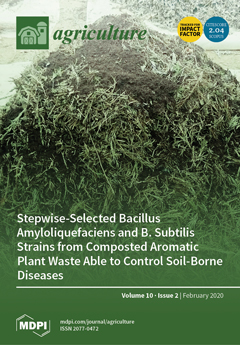Salicornia europaea, a halophytic species, was investigated to assess its ability to withstand salinity during seed germination, and to identify suitable indices to interpret salt tolerance at this delicate stage. Seed germination indices (germination percentage (GP), germination energy (GE), germination value (GV),
[...] Read more.
Salicornia europaea, a halophytic species, was investigated to assess its ability to withstand salinity during seed germination, and to identify suitable indices to interpret salt tolerance at this delicate stage. Seed germination indices (germination percentage (GP), germination energy (GE), germination value (GV), coefficient of germination velocity (CVG), germination rate index (GRI), germination peak value (GPV), mean germination time (MGT), and time to 50% germination (T
50)) were calculated under increasing salinity (0, 100, 200, 300, 400, and 600 mM NaCl). Principal component analysis (PCA) was used to describe the relationships involving the variables that account for data variance. Two salinity thresholds were identified (100 and 600 mM NaCl) determining significant decreases in all the indices, except for T
50 and MGT. In fact, PCA based on generated correlation circle showed significant negative correlations (
r close to −1) between salt stress and GP, GE, GRI, PV, GV, and CVG, whereas no correlation was observed with T
50 and MGT (
r close to zero). Based on this, GP, GE, GRI, PV, GV, and CVG can be considered useful traits to assess salt tolerance during germination in
S. europaea, while T
50 and MGT, that were not affected by the range of salinity levels investigated, should not be used for this purpose.
Full article





